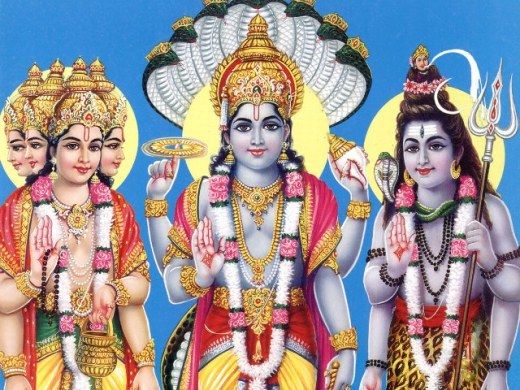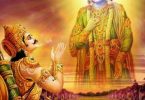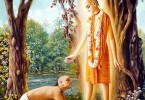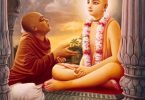Question : In Bhagavad Gita, Krishna claims Himself to be the only supreme Lord. But in Siva Gita (which is in Padmapurana) Siva claims that He is the only supreme Lord. Various puranas praise various Lords to be the supreme absolute truth. This is very much confusing and this suggests the possibility of scriptures being man made. It is obvious that Bhagavad Gita or Srimad Bhagavatam are not special since Siva Gita and other puranas can sufficiently counter the claims made by the above said scriptures. So how to know who the Almighty is?
Answer by Romapada Swami:
Different puranas and literatures are meant for those under different modes of nature – goodness, passion or ignorance. Each emphasizes different objects of worship according to the particular modes. According to the mode one is situated in, one’s faith varies (Ch 17, Bhagavad-gita). For example, someone influenced by mode of ignorance may resort to witch-craft or violence or some such unclean/harmful practices to attain their desires; someone in mode of passion may rely on their own capabilities or the favor of someone influential, but one situated in goodness may believe in righteous performance of duties and performing sacrifices to God as the means to good fortune. The Vedic literatures are meant to cater to all these classes of people, by strengthening the kinds of faith they are already inclined to in such a way that gradually they can be elevated to the mode of goodness and beyond. Because there are literatures for different kinds of people, obviously such literatures glorify different objects and highlight different practices as the supreme goal and means. Thus some fearsome practices of worshiping Goddess Kali may be repulsive to one in the mode of goodness, but that is what a person in ignorance can strongly place faith in.
Alternative to the hypothesis of scriptures being man-made, (the differences being due to different authors’ personal opinions), such differences may also suggest the work of a higher intelligence to encompass and provide for the spiritual upliftment of entire humanity regardless of the wide spectrum of their modes of nature, their corresponding faith, and their level of spiritual evolvement. This is the actual fact, because all the myriad Upanishads, puranas, upapuranas and so on were all compiled by one person — Srila Vyasadev — for the above said purpose.
A simple analogy may illustrate this idea: a professor in Math can outline syllabus for Math instruction for elementary, high school and university Math courses. Elementary math teaches that a greater number can never be subtracted from a smaller number, but as one learns the concept of negative numbers in higher grades, one knows better. Thus although the elementary and high school math seem contradictory, it is taught by the same person for those with different capabilities. If we understand that the same authority is behind all the different instructions, then it is easy to reconcile all contradictions.
True, it could be bewildering to sort through these seemingly contradictory statements and understand the final conclusion, and more often than not people resign thinking that everything must be relative, or that the Absolute is something void. Such conclusions are products of mundane logic and hence fallacious. It is like concluding that all math is wrong. The fact is that in such contradictory statements, both statements may be true, but one truth is a higher truth than the other! One fool-proof way to understand the real conclusion is to understand what the author himself has to say in conclusion.
At this point it becomes necessary to understand that Bhagavad-gita and Srimad Bhagavatam are in fact special evidences even among the other Vedic literature.
Srimad Bhagavatam, especially, is called amala purana (or spotless purana) meaning that it is beyond the three modes of material nature unlike the other puranas which give instructions within the modes of nature; thus it is identified as para-dharma. The Bhagavatam is described as the mature fruit of the Vedic tree, just as of all parts of a fruit-bearing tree, it’s ripened fruit is the most desired. There is indication even within the other puranas that among all the puranas Srimad Bhagavatam is the emperor, or ultimate authority. The puranas themselves indicate that any contradictions among them should be resolved by consulting Srimad Bhagavatam.
(The author’s intention is not to confuse us, so he himself gives hints and indications where to look for the final truth. Scriptural evidences of this are quoted in Jiva Gosvami’s Tattva sandarbha.)
The Bhagavatam was written by Vyasasdev in his complete maturity. As the history goes, Vyasadev completed all the Vedic scriptures including the Vedanta sutras and the puranas etc., and was still feeling despondent when he was instructed by Narada to compose a literature simply dedicated to the Absolute Truth without any distraction. (Please refer SB Ch 4-6) It was then that Vyasadev writes Srimad Bhagavatam, wherein he himself declares that all other literatures that don’t exclusively glorify the Supreme Absolute Truth propound “a cheating religion” but the Bhagavatam is devoid of all such cheating mentality and that the only Supreme Truth is Vaasudeva, the son of Devaki. (Cf. SB 1.1.2)
As mentioned before, other puranas do glorify some other Deity as exalted, and in a sense, it is true. For instance, Devi Bhagavat may glorify Durga as the creator, maintainer and annihilator of the cosmic manifestation and so on. This is a fact, these are not to be taken as mere stories to impress faith upon less intelligent. But as said before all these are relative truths, and thus dependent upon an Absolute Truth which is Krishna. Durga is the immediate cause of creation etc, whereas the efficient cause of all causes is Krishna. When Lord Brahma receives transcendental knowledge after thousands of years of penance, he offers prayers to the Supreme Lord and there he describes the entire cosmic situation. He states there that Durga creates, maintains and annihilates just as instrument to carry out the will of Govinda (Cf. Brahma Samhita) Similarly, Lord Shiva is in one sense non- different from Krishna; he is but a transformation of Vishnu, just as yogurt is but a transformation of milk. His glories cannot be minimized. Within the created region, he is the `Mahesvara’, the controller of all other isvaras, greater than even Lord Brahma. Thus his supremacy in the material world is established, even within Vaishnava literatures and the statements such as the one referred to by you are not false. However, even Lord Shiva is NOT SUPREMELY INDEPENDENT of Krishna. Sri Krishna alone claims “There is no other Truth beyond Me.” (BG 7.7) Lord Shiva is thus himself one of principal acaryas of the four bona fide sampradayas teaching Krishna bhakti to his followers. Even Sankaracarya (who is but an incarnation of Lord Shiva with a special mission to preach impersonalism and bewilder the atheists) concludes that only Narayana is beyond the material realm: `narayana paro `vyaktat’ etc.
Finally, I would like to mention that transcendental truth cannot be established merely by logical arguments and counter-arguments. Vedic authority is the final evidence, and in order to reconcile different interpretations of its conclusions, we may use logical inferences that establish the truth.
However, as Krishna recommends (Bg 4.34), the only way to conclusively understand the truth is by receiving guidance from self-realized souls or as said in Mahabharat, to follow such mahajanas as Prahlada, Bhisma, Brahma, Shiva, Narada etc. and by the grace of God.







